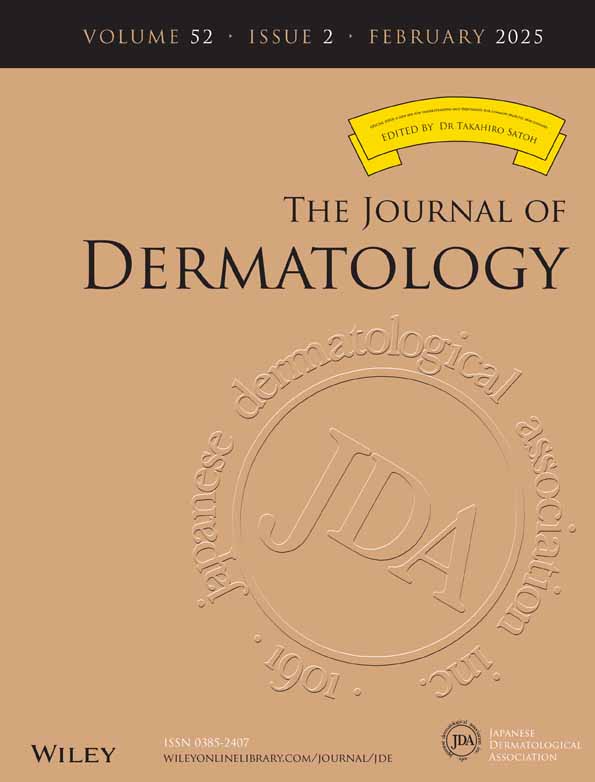Coexistence of Basan syndrome and cutaneous basal cell carcinoma: Genetic and clinical perspectives
Zhijie Luo
Department of Dermatology, Shenzhen People's Hospital (The Second Clinical Medical College, Jinan University; The First Affiliated Hospital, Southern University of Science and Technology), Shenzhen, Guangdong, China
School of Medicine, Southern University of Science and Technology, Shenzhen, Guangdong, China
These author contributed equally to this study and share first authorship.
Search for more papers by this authorYansi Lyu
Department of Dermatology, Shenzhen University General Hospital, Shenzhen, Guangdong, China
These author contributed equally to this study and share first authorship.
Search for more papers by this authorWenwu Dong
Department of Dermatology, Shenzhen People's Hospital (The Second Clinical Medical College, Jinan University; The First Affiliated Hospital, Southern University of Science and Technology), Shenzhen, Guangdong, China
Search for more papers by this authorZhongxi Mei
Department of Dermatology, Shenzhen People's Hospital (The Second Clinical Medical College, Jinan University; The First Affiliated Hospital, Southern University of Science and Technology), Shenzhen, Guangdong, China
Search for more papers by this authorCorresponding Author
Huijun Wang
Dermatology Hospital, Southern Medical University, Guangzhou, China
Correspondence
Fang Yang, Department of Dermatology, Shenzhen People's Hospital (The Second Clinical Medical College, Jinan University; The First Affiliated Hospital, Southern University of Science and Technology), Shenzhen 518020, Guangdong, China.
Email: [email protected]
Huijun Wang, Dermatology Hospital, Southern Medical University, Guangzhou 510091, China.
Email: [email protected]
Search for more papers by this authorCorresponding Author
Fang Yang
Department of Dermatology, Shenzhen People's Hospital (The Second Clinical Medical College, Jinan University; The First Affiliated Hospital, Southern University of Science and Technology), Shenzhen, Guangdong, China
Candidate Branch of National Clinical Research Center for Skin Diseases, Shenzhen, Guangdong, China
Correspondence
Fang Yang, Department of Dermatology, Shenzhen People's Hospital (The Second Clinical Medical College, Jinan University; The First Affiliated Hospital, Southern University of Science and Technology), Shenzhen 518020, Guangdong, China.
Email: [email protected]
Huijun Wang, Dermatology Hospital, Southern Medical University, Guangzhou 510091, China.
Email: [email protected]
Search for more papers by this authorZhijie Luo
Department of Dermatology, Shenzhen People's Hospital (The Second Clinical Medical College, Jinan University; The First Affiliated Hospital, Southern University of Science and Technology), Shenzhen, Guangdong, China
School of Medicine, Southern University of Science and Technology, Shenzhen, Guangdong, China
These author contributed equally to this study and share first authorship.
Search for more papers by this authorYansi Lyu
Department of Dermatology, Shenzhen University General Hospital, Shenzhen, Guangdong, China
These author contributed equally to this study and share first authorship.
Search for more papers by this authorWenwu Dong
Department of Dermatology, Shenzhen People's Hospital (The Second Clinical Medical College, Jinan University; The First Affiliated Hospital, Southern University of Science and Technology), Shenzhen, Guangdong, China
Search for more papers by this authorZhongxi Mei
Department of Dermatology, Shenzhen People's Hospital (The Second Clinical Medical College, Jinan University; The First Affiliated Hospital, Southern University of Science and Technology), Shenzhen, Guangdong, China
Search for more papers by this authorCorresponding Author
Huijun Wang
Dermatology Hospital, Southern Medical University, Guangzhou, China
Correspondence
Fang Yang, Department of Dermatology, Shenzhen People's Hospital (The Second Clinical Medical College, Jinan University; The First Affiliated Hospital, Southern University of Science and Technology), Shenzhen 518020, Guangdong, China.
Email: [email protected]
Huijun Wang, Dermatology Hospital, Southern Medical University, Guangzhou 510091, China.
Email: [email protected]
Search for more papers by this authorCorresponding Author
Fang Yang
Department of Dermatology, Shenzhen People's Hospital (The Second Clinical Medical College, Jinan University; The First Affiliated Hospital, Southern University of Science and Technology), Shenzhen, Guangdong, China
Candidate Branch of National Clinical Research Center for Skin Diseases, Shenzhen, Guangdong, China
Correspondence
Fang Yang, Department of Dermatology, Shenzhen People's Hospital (The Second Clinical Medical College, Jinan University; The First Affiliated Hospital, Southern University of Science and Technology), Shenzhen 518020, Guangdong, China.
Email: [email protected]
Huijun Wang, Dermatology Hospital, Southern Medical University, Guangzhou 510091, China.
Email: [email protected]
Search for more papers by this author
REFERENCES
- 1Límová M, Blacker KL, LeBoit PE. Congenital absence of dermatoglyphs. J Am Acad Dermatol. 1993; 29: 355–358.
- 2Sachs P, Ding D, Bergmaier P, Lamp B, Schlagheck C, Finkernagel F, et al. SMARCAD1 ATPase activity is required to silence endogenous retroviruses in embryonic stem cells. Nat Commun. 2019; 10: 1335.
- 3Chang X, Li D, Tian L, Liu Y, March M, Wang T, et al. Heterozygous deletion impacting SMARCAD1 in the original kindred with absent dermatoglyphs and associated features (Baird, 1964). J Pediatr. 2018; 194: 248–252.
- 4Loh AY, Špoljar S, Neo GY, Escande-Beillard N, Leushacke M, Luijten MN, et al. Huriez syndrome: additional pathogenic variants supporting allelism to SMARCAD syndrome. Am J Med Genet A. 2022; 188: 1752–1760.
- 5Grigatti M, Pescarini E, Salmaso R, Gardener C, Brambullo T, Vindigni V. Huriez syndrome associated with basal cell carcinoma. Ann Ital Chir. 2020; 9: 1–4.




